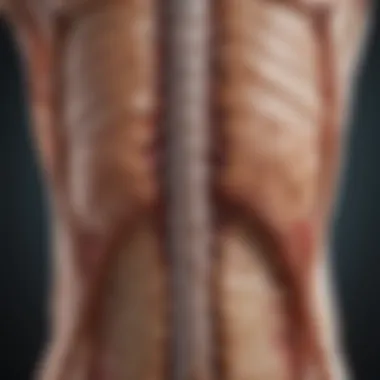Understanding Acute Transverse Myelitis: A Detailed Guide


Intro
Acute transverse myelitis (ATM) is a significant health issue that affects the spinal cord. This condition results from inflammation, disrupting the communication between the spinal cord and the brain. This leads to a variety of motor, sensory, and autonomic problems. Understanding ATM is vital for both the medical community and the individuals affected by the condition. The following sections provide a detailed examination of ATM, from its definition to its long-term implications.
Article Overview
Purpose of the Article
This article seeks to provide a thorough investigation into acute transverse myelitis. It articulates the intricate mechanisms involved and outlines the clinical journey from diagnosis to treatment. By synthesizing current research evidence and professional insights, this article aims to enhance the understanding of ATM.
Relevance to Multiple Disciplines
The complexities of ATM necessitate input from various fields such as neurology, immunology, and rehabilitation. Healthcare professionals will find this discourse significant for improving diagnostic methods and treatment strategies. Additionally, researchers can utilize the information to explore further studies related to the pathophysiological aspects of ATM.
Research Background
Historical Context
Acute transverse myelitis was first widely documented in medical literature during the late 19th century. Its recognition as a distinct clinical entity has evolved over the years. Initial cases were often attributed to infectious causes. However, contemporary understanding has expanded to include autoimmune and demyelinating factors as contributors.
Key Concepts and Definitions
To clarify the discussion, it is essential to define several key terms related to ATM:
- Acute: Refers to the rapid onset of symptoms, typically occurring over hours to days.
- Transverse Myelitis: This term describes inflammation across both sides of one segment of the spinal cord. It can disrupt various functions depending on which segment is affected.
- Demyelination: This process involves damage to the myelin sheath, which covers nerve fibers, hindering their ability to conduct signals.
The interplay of these definitions establishes a foundation for further understanding the mechanisms and impact of ATM.
"Acute transverse myelitis presents not only as a medical challenge but as a multifaceted condition requiring comprehensive management strategies."
"Acute transverse myelitis presents not only as a medical challenge but as a multifaceted condition requiring comprehensive management strategies."
Pathophysiological Mechanisms
While discussing ATM, it is crucial to explore its pathophysiological mechanisms. The damage caused by inflammation can lead to neural deficits that manifest as weakness or sensory changes. Understanding these mechanisms allows healthcare professionals to better grasp the complexities of the condition.
Interdisciplinary Approaches
Effective management of ATM often requires collaboration among various healthcare professionals including neurologists, physiotherapists, and psychologists. Such teamwork promotes a holistic approach toward treatment, enhancing patient outcomes.
Preamble to Acute Transverse Myelitis
Acute Transverse Myelitis (ATM) is a complex neurological condition that warrants careful study and understanding. The significance of delving into this topic lies in its potential impact on patient outcomes and quality of life. Many healthcare professionals and researchers may encounter patients with symptoms indicative of ATM, yet the vast array of presentations necessitates a thorough grasp of the disease.
Understanding ATM not only aids in recognizing the symptoms but also facilitates timely diagnosis and treatment. As a rare but serious condition characterized by inflammation of the spinal cord, ATM can lead to debilitating motor, sensory, and autonomic dysfunctions. This article explores its intricacies, ensuring that readers are equipped with knowledge that is both comprehensive and critical for effective clinical practice and research.
Defining Acute Transverse Myelitis
Acute Transverse Myelitis is defined as an inflammatory disorder affecting the gray and white matter of the spinal cord. This condition can disrupt normal neural transmission, leading to varying symptoms depending on the location and extent of inflammation. While it can occur in isolation, ATM is often associated with infectious diseases, autoimmune disorders, or post-viral syndromes.
The acute onset of symptoms is a hallmark of ATM, which may include weakness, sensory alterations, and bladder dysfunction. Early identification is essential; hence, clear definitions and clinical guidelines are vital for healthcare professionals.
Historical Context and Significance
The historical context of Acute Transverse Myelitis reflects a gradual evolution in the understanding of neurological disorders. Earlier medical writings often lacked the specificity needed to diagnose ATM accurately. Over the years, advancements in medical imaging and immunological research have enhanced the ability to identify and categorize this condition.
Research studies from the 20th century laid the groundwork for contemporary interpretations of ATM. Notably, shifts in the focus from primarily infectious causes to a broader spectrum that includes autoimmune mechanisms have improved how clinicians address the illness. This historical perspective underscores the importance of ongoing research and interdisciplinary collaboration.
"A comprehensive understanding of Acute Transverse Myelitis integrates historical insights with contemporary practice, shaping effective therapeutic strategies."
"A comprehensive understanding of Acute Transverse Myelitis integrates historical insights with contemporary practice, shaping effective therapeutic strategies."
Understanding both the definition and historical significance of ATM underscores necessity for informed medical practice and patient care. We aim to foster knowledge that bridges past experiences with current clinical approaches.
Etiology of Acute Transverse Myelitis
Understanding the etiology of Acute Transverse Myelitis (ATM) is crucial, as it encompasses the various underlying factors that can lead to this complex condition. Identifying the causes of ATM not only aids in accurate diagnosis but also guides treatment strategies and informs prognosis. By comprehensively exploring infectious causes, autoimmune mechanisms, as well as vascular and metabolic factors, we build a clearer picture of how this rare disorder manifests and progresses in individuals. Recognizing these elements empowers healthcare professionals to tailor patient care effectively, enhancing the chances of favorable outcomes.
Infectious Causes
Infectious agents are one of the primary triggers for ATM. Various viruses and bacteria can provoke inflammation in the spinal cord. Notably, viral infections, such as those caused by the herpes simplex virus, varicella-zoster virus, and cytomegalovirus, have been frequently associated with this ailment. Other pathogens, including Lyme disease bacteria and certain enteroviruses, have also been implicated.
The mechanisms by which these infections lead to ATM vary. An infectious agent may directly invade the spinal cord, causing localized inflammation. Alternatively, post-infectious inflammatory responses can occur. This phenomenon suggests that an individual's immune system may mistakenly attack neural tissue following an infection, resulting in demyelination and consequent neurological deficits. Given these complexities, accurate microbial identification through laboratory testing is essential for effective management.
Autoimmune Mechanisms


Autoimmunity plays a significant role in the etiology of Acute Transverse Myelitis. Conditions like multiple sclerosis and neuromyelitis optica can lead to ATM through autoimmune attacks on the central nervous system. In such cases, the body's immune response mistakenly targets its own cells, damaging the myelin sheath that surrounds nerve fibers in the spinal cord.
These autoimmune reactions can be triggered by a variety of factors, including infections or environmental influences. Identifying the presence of specific antibodies in a patient can help delineate whether ATM is related to an autoimmune process. Moreover, some individuals might experience ATM as an isolated event without a prior diagnosis of an autoimmune disorder. In these instances, the underlying etiology might only become evident through careful monitoring and follow-up care.
Vascular and Metabolic Factors
Vascular complications can also contribute to the development of Acute Transverse Myelitis. Conditions such as spinal cord ischemia, which results from interrupted blood flow, or inflammation of blood vessels can lead to myelopathy. These vascular issues may stem from various underlying problems, including clotting disorders and systemic diseases affecting vascular health.
Metabolic factors, on the other hand, can influence the risk of developing ATM. Nutritional deficiencies, especially those involving vitamin B12, can lead to myelopathy symptoms that may mimic those of ATM. Furthermore, certain metabolic disorders can result in generalized inflammatory responses that can affect the spinal cord.
In summary, understanding the multifaceted etiology of Acute Transverse Myelitis is vital for healthcare practitioners. It influences the approach to diagnosis, informs treatment options, and shapes patient prognoses. A thorough investigation into these causes can unveil the complexities of ATM, leading to better outcomes for patients.
Pathophysiology of Acute Transverse Myelitis
Understanding the pathophysiology of acute transverse myelitis (ATM) is essential, as it reveals the underlying mechanisms driving this condition. Such knowledge aids in proper diagnosis, informs therapeutic strategies, and helps predict patient outcomes. ATM is characterized by inflammation and damage to the spinal cord, leading to diverse clinical manifestations.
Inflammation and Demyelination
At the core of ATM is inflammation that primarily targets the spinal cord's transverse sections. This inflammatory process disrupts myelin, the protective sheath surrounding nerve fibers. The presence of inflammatory mediators such as cytokines and chemokines plays a pivotal role. They attract immune cells to the site of demyelination, exacerbating tissue injury and leading to potential permanent damage to the nervous system.
Research has demonstrated that the inflammatory response is often triggered by infections or autoimmune reactions. This is crucial in understanding how certain viral or bacterial pathogens might instigate ATM. Furthermore, biochemical pathways involved offer avenues for therapeutic developments that could mitigate the inflammatory response.
Impact on Neural Transmission
The damage caused by inflammation and demyelination has dire consequences on neural transmission. The loss of myelin impacts the speed and efficiency with which nerve impulses travel along axons. This results in various neurological symptoms depending on the extent of damage and the specific spinal cord regions affected.
"The transmission of electrical signals is crucial for muscle movement and perception of sensations. Any disruption can lead to significant impairment."
"The transmission of electrical signals is crucial for muscle movement and perception of sensations. Any disruption can lead to significant impairment."
For example, when the motor pathways are involved, patients may experience weakness or paralysis. Conversely, involvement of sensory pathways often results in altered sensations or numbness. Moreover, autonomic dysfunction may arise due to disruption in the neural circuits that control involuntary functions, further complicating patient presentation.
Clinical Manifestations
Understanding the clinical manifestations of acute transverse myelitis is crucial. This section delves into how the condition impacts patients, and why identifying symptoms early can influence treatment outcomes. Recognizing the signs allows for timely intervention, which can enhance the quality of care provided.
Motor Symptoms
Motor symptoms are primarily associated with muscle weakness and functional impairment. Patients may experience reduced strength in the limbs, affecting their ability to perform daily tasks. Weakness can occur either in a specific area or throughout the body, leading to difficulties in walking or even standing.
In some cases, patients may face spasticity, where muscles become stiff and resistant to movement. This can create discomfort and hinder rehabilitation processes. Recognizing motor symptoms promptly is key for setting up an effective management plan.
- Symptoms include:
- Weakness in arms or legs
- Stiffness of muscles
- Difficulty in balance or coordination
Sensory Symptoms
Sensory symptoms can significantly alter how patients perceive their environment. Many experience numbness, tingling, or altered sensation, particularly below the level of the spinal cord lesion. This can lead to a disturbing sense of awareness and may impact daily living.
Patients often describe a "band-like" sensation around the torso, referred to as "girdle sensation." This highlights the complex interaction between inflammation and nerve function. Understanding these symptoms is essential for healthcare providers in order to guide therapeutic strategies.
- Common sensory changes:
- Numbness
- Tingling sensations
- Heightened sensitivity to touch or pain
Autonomic Dysfunction
Autonomic dysfunction represents a critical aspect of acute transverse myelitis, as it impacts involuntary bodily functions. This can lead to issues such as bladder and bowel dysfunction. Patients may find it challenging to control urination or experience constipation. Such symptoms can cause significant distress and affect the quality of life.
Moreover, symptoms of dysautonomia, such as changes in blood pressure and heart rate, may also present. This can amplify the clinical complexity of the condition, necessitating a multidisciplinary approach to care. Identifying these dysfunctions early can lead to prompt treatment options like bladder training and medication.
- Autonomic symptoms can include:
- Bladder control issues
- Bowel dysfunction
- Blood pressure fluctuations
Understanding motor, sensory, and autonomic symptoms allows healthcare professionals to devise appropriate therapeutic interventions tailored to the patient's unique needs.
Understanding motor, sensory, and autonomic symptoms allows healthcare professionals to devise appropriate therapeutic interventions tailored to the patient's unique needs.
Diagnostic Approaches
The diagnostic approaches to Acute Transverse Myelitis (ATM) are essential for accurate identification and effective management of this complex condition. Given its rarity and the overlap with other neurological disorders, utilizing a multifaceted diagnostic strategy is paramount. This section will explore clinical assessment techniques, imaging modalities, and laboratory evaluations which collectively enhance diagnostic precision and guide treatment options.
Clinical Assessment Techniques


Clinical assessment serves as the foundation for diagnosing ATM. A thorough patient history is crucial. This includes understanding recent infections, vaccination history, and neurological symptoms onset. Medical professionals should perform a detailed neurological examination, focusing on:
- Motor function: Assessing strength and tone in limbs.
- Sensory function: Evaluating touch, pain, temperature, and proprioception.
- Reflexes: Checking deep tendon reflexes and eliciting pathological reflexes.
Recognizing patterns in symptoms is key. For instance, a rapid onset of weakness in both legs alongside sensory changes may point toward ATM. Clinicians also consider the age and overall health of the patient, which can influence the presentation and prognosis. It is important to maintain a high index of suspicion, as early and accurate diagnosis leads to better management outcomes.
Imaging Modalities
Imaging techniques are integral to confirming the diagnosis of ATM. MRI is the most sensitive tool for visualizing spinal cord abnormalities. Key aspects include:
- Lesion location: ATM typically presents as a contiguous area of signal abnormalities in the spinal cord.
- Extent of inflammation: The size and degree of the lesion can help differentiate ATM from other conditions, such as multiple sclerosis.
In some cases, MRI with contrast may further elucidate inflammation and exclude other possibilities. A CT scan can be used but is less effective than MRI in depicting soft tissue structures like the spinal cord.
Laboratory Evaluations
Laboratory evaluations, while not definitive for ATM, support diagnosis through the identification of underlying causes. Essential tests include:
- Lumbar puncture: Cerebrospinal fluid analysis can reveal elevated white blood cells, indicating inflammation. The presence of specific antibodies may suggest an autoimmune origin.
- Blood tests: Screening for infectious agents and autoimmune markers is critical. Tests may check for conditions like lupus or Sjögren's syndrome, which can mimic ATM symptoms.
The integration of these elements provides a comprehensive assessment, leading to a more accurate diagnosis. It is crucial for medical practitioners to remain vigilant and consider all diagnostic methods to differentiate ATM from similar neurological conditions.
Key Insight: A multi-pronged approach combining clinical assessment, imaging, and laboratory evaluations significantly increases diagnostic accuracy and informs therapeutic decisions.
Key Insight: A multi-pronged approach combining clinical assessment, imaging, and laboratory evaluations significantly increases diagnostic accuracy and informs therapeutic decisions.
Differential Diagnosis
The process of differential diagnosis is a critical aspect in the clinical evaluation of acute transverse myelitis (ATM). Due to the overlapping symptoms with other neurological disorders, establishing a correct diagnosis is vital. This approach ensures that patients receive appropriate treatment in a timely manner. Inaccurate or delayed diagnoses can lead to ineffective management and poorer outcomes. Therefore, understanding the nuances of differential diagnosis plays a significant role in the overall care of patients exhibiting symptoms of ATM.
Multiple Sclerosis
Multiple sclerosis (MS) is one of the primary conditions to consider when diagnosing ATM. Both disorders can cause similar neurological impairments, particularly affecting motor and sensory functions. However, the patterns of symptoms and progression often differ. In MS, symptoms may appear in episodes, with periods of remission. In contrast, ATM typically presents acutely and progresses more rapidly without significant recovery phases early on.
Clinical assessments for MS often include magnetic resonance imaging (MRI) to identify lesions in the central nervous system. Identifying oligoclonal bands in cerebrospinal fluid (CSF) can also aid in distinguishing MS from ATM. Clinicians must be meticulous in these evaluations, as the management strategies for MS differ considerably from those for ATM, thus reinforcing the need for accurate differential diagnosis.
Neuromyelitis Optica Spectrum Disorder
Neuromyelitis optica spectrum disorder (NMOSD) is another condition that shares symptoms with ATM, especially involving spinal cord demyelination. The distinction is essential since treatments for NMOSD, such as monoclonal antibodies, can differ profoundly from the therapeutic approaches for ATM.
Unique to NMOSD are optic neuritis and specific antibody markers, including aquaporin-4 antibodies, which can help solidify this diagnosis. The presentation of NMOSD typically involves more diffuse spinal involvement, distinguishing it from the focal characteristics of ATM. Recognition of these nuances is key for proper management and improved patient outcomes.
Other Spinal Cord Disorders
Several other spinal cord disorders require consideration during differential diagnosis. Conditions such as acute disseminated encephalomyelitis (ADEM), transverse myelitis due to infections, or compressive myelopathy can mirror the clinical picture of ATM.
A thorough evaluation may involve neuroimaging studies, CSF analysis, and clinical examinations to discern these conditions. Specific signs, such as the presence of fever in infectious causes or distinct imaging findings in compressive myelopathy, can help in establishing a clear distinction.
In summary, the differential diagnosis of acute transverse myelitis is a multifaceted process that mandates careful consideration of various neurological disorders. Accurate identification of ATM among these conditions is crucial for effective intervention and better patient outcomes.
Therapeutic Strategies
The therapeutic strategies for acute transverse myelitis (ATM) are crucial to manage the disease effectively and mitigate long-term impacts on the patient. Understanding these strategies can aid healthcare professionals in determining the best course of action tailored to individual patient needs. These strategies can be broadly categorized into acute management and rehabilitation approaches, each focusing on specific aspects of treatment and recovery.
Acute Management
Use of Corticosteroids
Corticosteroids are a critical component in the treatment of acute transverse myelitis. Their role involves reducing inflammation in the spinal cord, which is central to the pathology of this condition. Corticosteroids, such as methylprednisolone, are noted for their anti-inflammatory properties. This characteristic makes them a popular choice for clinicians aiming for rapid amelioration of symptoms. The key advantage of corticosteroids is their ability to quickly reduce the disease process. However, side effects, including risk of infections, must be considered.
Administration of Intravenous Immunoglobulin
Another vital therapeutic option is the administration of intravenous immunoglobulin (IVIG). This therapy is particularly advantageous in cases where autoimmune mechanisms are suspected. The primary function of IVIG is to modulate the immune response, which can be beneficial in preventing further damage to the spinal cord. A unique feature of IVIG is that it can provide both immunomodulatory and neuroprotective effects. Nevertheless, it can also be expensive, leading to considerations about its accessibility in various healthcare settings.
Plasma Exchange Therapy
Plasma exchange therapy, or plasmapheresis, is a more aggressive treatment that may also benefit those with findings suggestive of acute transverse myelitis. This therapy removes harmful antibodies and inflammatory mediators from the bloodstream. Its key characteristic is its rapid application in severely affected patients. The advantage of plasma exchange is the potential for quick reduction in symptoms, making it a favorable choice when traditional corticosteroids or IVIG may not be effective. However, the procedure requires specialized equipment and trained personnel, which may limit its availability.
Rehabilitation Approaches
After acute management, rehabilitation strategies play a significant role in patient recovery. These approaches target motor, sensory, and cognitive functions that may be impaired due to the disease.
Physical Therapy Considerations
Physical therapy is essential for patients recovering from acute transverse myelitis. This aspect of rehabilitation focuses on restoring mobility and strength. Physical therapy can involve a variety of exercises tailored to individual abilities and needs. A primary advantage is improved physical function and independence. However, recovery varies, and results can depend on the severity of the initial condition.


Occupational Therapy Strategies
Occupational therapy addresses daily living activities that can be affected by ATM. These strategies emphasize adaptive techniques and tools to help patients regain autonomy. A key characteristic of this therapy is its personalized approach, modifying tasks to fit the patient’s capabilities. The advantage lies in improving quality of life, allowing individuals to re-engage with their personal, work, and social environments. The downside could be the need for ongoing support, which varies between patients.
Cognitive Rehabilitation
Cognitive rehabilitation may also be relevant for some ATM patients, especially if cognitive deficits have emerged due to spinal cord involvement. This approach aims to enhance cognitive function through various strategies, including memory exercises and problem-solving tasks. A significant aspect is its customization to target specific cognitive weaknesses. The benefit of cognitive rehabilitation is the potential for improved functional cognitive abilities. Conversely, the effects may not always meet patient expectations, necessitating patient support and education throughout the process.
"The integration of therapeutic strategies is vital for comprehensive care in acute transverse myelitis, aiming not only to treat symptoms but also to improve overall quality of life."
"The integration of therapeutic strategies is vital for comprehensive care in acute transverse myelitis, aiming not only to treat symptoms but also to improve overall quality of life."
Understanding these therapeutic strategies provides a foundation for both immediate and long-term care of patients with acute transverse myelitis. The nuanced approach combines medical intervention with rehabilitation, ensuring better recovery outcomes.
Prognosis and Outcomes
Understanding the prognosis and outcomes of acute transverse myelitis (ATM) is vital for both patients and healthcare providers. This focus allows for a realistic appreciation of potential recovery trajectories and the long-term functional implications that can influence individuals' quality of life. Each patient's experience with ATM is different, which renders prognosis a multifaceted aspect deserving thorough exploration.
Factors Influencing Recovery
Recovery from ATM is contingent on various elements that intertwine to shape individual outcomes. These factors include:
- Extent of spinal cord damage: The degree of inflammation and demyelination can notably influence recovery. If lesions on the spinal cord are extensive, the potential for full recovery diminishes.
- Timing of treatment: Early intervention often correlates with better outcomes. The administration of corticosteroids or other therapies within a critical window can mitigate damage and promote healing.
- Individual variability: Genetic factors, overall health, and pre-existing conditions also play a role. Younger individuals or those without comorbidities generally exhibit better recovery rates.
- Rehabilitation efforts: Engaging in consistent rehabilitation therapies can enhance recovery. Personalized physical and occupational therapy is crucial for restoring motor function and improving daily living skills.
The interplay of these factors underpins a patient's recovery path. The importance of awareness regarding these influences cannot be overstated, as they provide a framework for steering treatment plans and setting realistic expectations.
Long-Term Functional Impact
The long-term functional impact of acute transverse myelitis can be profound. Many survivors deal not only with physical challenges but also psychological and social ramifications. Key considerations include:
- Mobility and independence: Some patients may achieve full recovery, while others might endure varying degrees of paralysis. This discrepancy can affect their ability to walk independently or use assistive devices, complicating daily interactions and routines.
- Neuropathic pain: Chronic pain is a common struggle for many individuals post-ATM. Ongoing pain management requires careful assessment to alleviate discomfort and enhance quality of life.
- Psychosocial implications: The impact on mental health, including anxiety and depression, must be acknowledged and addressed. Patients may struggle with adaptations to their life circumstances, emphasizing the need for comprehensive support.
- Employment and social roles: Returning to work or maintaining social engagements can become significant challenges. Employers and peers need to understand the condition to foster inclusive environments for affected individuals.
The long-term outlook for individuals following ATM is variable and complex. As such, continuous research into effective therapeutic strategies and holistic approaches to care is crucial.
"Acknowledging the prognosis and preparing for potential outcomes can empower patients and families to navigate the challenges posed by acute transverse myelitis effectively."
"Acknowledging the prognosis and preparing for potential outcomes can empower patients and families to navigate the challenges posed by acute transverse myelitis effectively."
Research Frontiers
The exploration of research frontiers in acute transverse myelitis (ATM) is crucial for enhancing our understanding of this complex condition. It encompasses a range of recent findings and future directions that aim to improve patient outcomes and treatment strategies. Keeping abreast of the latest developments can offer significant benefits for clinicians, researchers, and patients alike.
Current Studies and Findings
Numerous studies are currently investigating the pathophysiology and treatment of ATM. Research is focusing on how inflammation and immune responses contribute to the condition. For instance, recent studies have identified specific biomarkers in the cerebrospinal fluid that correlate with disease severity. This can help in understanding the progression of the illness and tailoring personalized treatment approaches.
Another area of interest is the role of genetic predispositions in ATM. Researchers are examining how certain genetic factors may influence the severity and response to treatments. This insight could lead to targeted therapies for those more susceptible to severe manifestations of the disease.
Ongoing clinical trials are evaluating new therapeutic strategies. Some studies focus on alternative immunotherapies that show promise beyond corticosteroids. Early results are suggesting that these therapies may reduce long-term disability in some patients. Additionally, researchers are looking into rehabilitation techniques that enhance recovery of motor skills and independence.
Future Directions in Research
Looking ahead, the future of ATM research holds great promise. A significant focus is likely to be on multi-disciplinary approaches, blending neurology, immunology, and rehabilitative sciences. This combination can provide a more holistic understanding of the factors affecting recovery and chronicity in patients.
Additionally, there is a growing need for developing standardized diagnostic criteria for ATM. This is fundamental to compare treatment outcomes effectively across different studies. Standardization can foster collaborative research efforts, ultimately leading to a better understanding of the disease.
Moreover, the integration of technology in monitoring and treatment is poised to gain traction. Wearable devices and app-based platforms can assist in real-time tracking of symptoms and rehabilitation progress. This data can enhance clinical decision-making and facilitate more adaptive care plans.
Ending
The conclusion serves as a vital component of this article by encapsulating the essential themes and insights discussed throughout the text. Understanding acute transverse myelitis (ATM) requires a comprehensive approach that brings together various elements such as its pathophysiology, diagnostic methods, and therapeutic strategies. One important aspect here is the nature of ATM as a multifactorial disease, making effective management contingent upon a thorough grasp of its underlying mechanisms.
Moreover, summarizing key facts supports both clinicians and researchers. It reminds professionals of the critical need for a nuanced understanding of the condition that goes beyond mere symptom recognition. For individuals affected by ATM and their families, these insights provide hope and clarity.
In essence, the conclusion distills the complexity of ATM into digestible portions. It empowers readers by highlighting the multi-disciplinary aspects of care that should be applied when managing this rare yet impactful condition.
Summary of Key Points
In summary, several critical points emerge from the discussions in this article:
- Definition: ATM is characterized by spinal cord inflammation resulting in motor, sensory, and autonomic dysfunction.
- Etiology: The causes of ATM range from infectious agents to autoimmune responses, requiring careful evaluation.
- Pathophysiology: Inflammation leads to demyelination, disrupting neural transmission and functionality.
- Clinical Symptoms: Patients present with a variety of symptoms, necessitating comprehensive examinations for accurate assessment.
- ** Diagnostic Approaches**: Clinicians utilize imaging and laboratory evaluations to discern ATM from similar disorders.
- Treatment Strategies: Both acute management and rehabilitation play important roles in patient recovery.
These points underline the diverse facets of ATM and underscore the importance of an interdisciplinary management approach.
Implications for Clinical Practice
The implications of the findings for clinical practice are significant. First, the understanding of ATM can assist healthcare professionals in:
- Improved Diagnosis: By being familiar with ATM's unique features and symptoms, clinicians will be better equipped to differentiate it from other spinal cord disorders.
- Tailored Treatment Plans: Knowledge of various therapeutic strategies allows for personalized care tailored to individual patient needs.
- Enhanced Patient Education: Educating patients about their condition fosters better adherence to treatment regimens and improves overall quality of life.
Overall, the insights gained from this article on acute transverse myelitis not only contribute to the academic discourse but also to everyday clinical practices. Understanding the nuances of ATM is essential in ensuring that affected individuals receive the most effective care possible.



